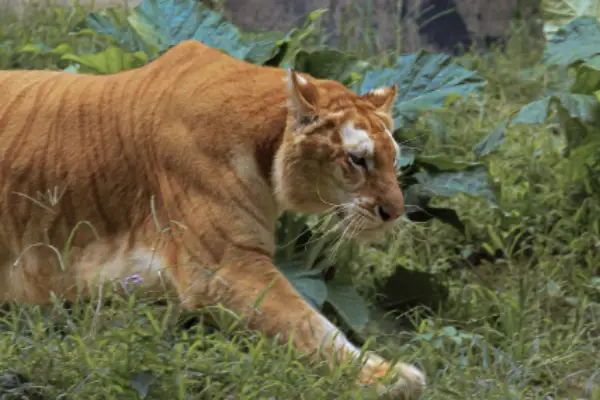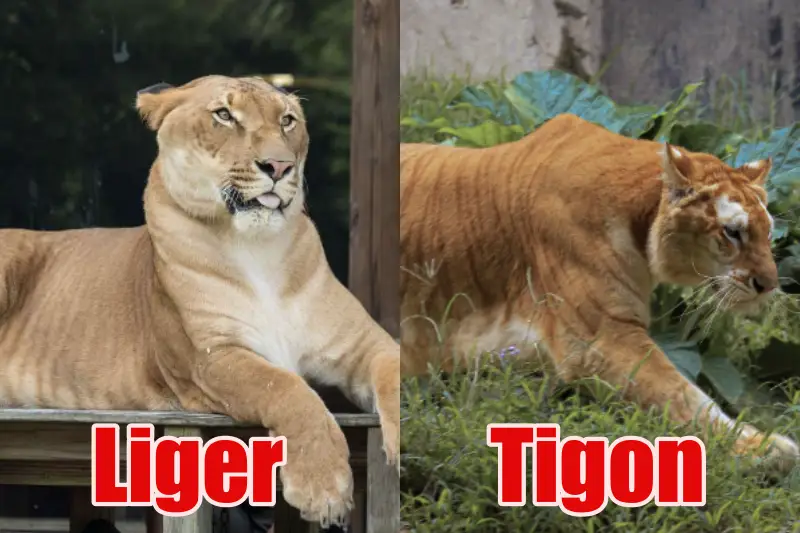Ligers and tigons unfold a captivating tale of genetic marvels in the animal kingdom. They are truly exceptional creatures, showcasing a fascinating blend of physical and behavioral traits inherited from their lion and tiger parentage.
While each one possesses its unique variations, tigons generally tend to be smaller, while ligers proudly hold the distinction of being the largest big cats on the planet.
If, like me, you’re still marveling at the wonders that nature, with a little assistance from science and humans, can offer, then you’ve come to the right place!
Keep reading as we unlock a new realm of creatures with distinct and fascinating features!
What is a Liger?

The liger, a mesmerizing marvel of the animal kingdom, is a unique offspring of a male lion and a tigress. These grand felines inherit the distinctive characteristics of their parents, combining the sociable nature of lions with their love for swimming, a trait commonly associated with tigers.
Originating in early 19th-century India, it wasn’t until the 1930s that it received its elegant name, artfully combining “lion” and “tiger.” What truly distinguishes these creatures is their remarkable size; the males can reach lengths of up to 3.6 meters, surpassing both lions and tigers in sheer magnitude.
Beyond their size, ligers boast a captivating coat adorned with subtle tiger-like stripes set against a tawny backdrop, adding to their unique appearance.
Despite their rarity and undeniable charm, concerns surrounding the health of these magnificent creatures make liger breeding a contentious issue.
What is a Tigon?

Now, let’s turn our attention to the captivating tigon. This extraordinary hybrid is born from the union of a male tiger and a lioness, resulting in a creature that showcases the perfect blend of both parents.
With spots inherited from their lioness genes and stripes passed down from the male tiger, tigons display a mesmerizing fusion of features.
Although tigons don’t grow as large as their parent species, typically weighing around 180 kilograms, it’s intriguing to note that initial doubts about their fertility have been slowly disregarded, with female tigons demonstrating the ability to have offspring.
They can even produce second-generation hybrids like the litigon, creating some truly remarkable big cats. While it’s not common to see tigons or ligers in the wild, these mesmerizing creatures continue to capture our imaginations, reminding us of the incredible diversity of the animal kingdom.
Key Differences between Liger and Tigon
| Characteristics | Liger | Tigon |
| Parent Species | A male lion and a female tiger | A male tiger and a female lion |
| Size | 3- 3.6 meters | 1.9-2.7 meters |
| Location and Habitat | Controlled environments like zoos and wildlife sanctuaries | Like ligers, they primarily reside in zoos and wildlife sanctuaries. |
| Appearance | Often grows larger than both of their parent species. Its coat features faint tiger-like stripes against a tawny backdrop. | They often showcase spots reminiscent of their lioness mothers and stripes inherited from their tiger fathers. |
| Fertility | Male ligers are typically sterile. In contrast, female ligers are often fertile and capable of reproducing, occasionally giving birth to second-generation hybrids. | Like ligers, male tigons are typically sterile, and unable to produce offspring. Female tigons are often fertile, raising the possibility of second-generation hybrids. |
| Behavior | They are known for their sociable nature, reflecting the characteristics of lions. They also enjoy swimming, like their mother, the tiger. | They have sociable tendencies from lions and a liking for swimming, a trait often associated with tigers. |
I. Liger vs. Tigon: Parent Species
The primary distinction between tigons and ligers lies in their parentage. Tigons, the offspring of a male tiger and a lioness, carry the genetic heritage of both the agile tiger (Panthera tigris) and the majestic lion (Panthera leo).
In contrast, ligers emerge from the union of a male lion and a tigress, representing a combination of genes from both a lion and a tiger. These hybrid pairings result in fascinating variations in the genetic makeup and physical traits of tigons and ligers.
II. Liger vs. Tigon: Size
Size is one of the most prominent characteristics that sets Liger and Tigon apart. Ligers often claim the title of the world’s largest big cats. Males of this hybrid can reach impressive lengths of 3 to 3.6 meters (9.8 to 11.8 feet), much larger than both lions and tigers. This large size is due to certain genes being imprinted in the offspring not seen in the naturally occurring tiger to lion, which affects their growth patterns.
Tigons, on the other hand, maintain a more moderate size, not exceeding their parent species. They typically weigh around 180 kilograms (400 pounds), making them smaller in comparison to their liger counterparts. Most of them grow between the lengths of 1.9 and 2.7 meters.
III. Liger vs. Tigon: Location and Habitat
Both tigons and ligers are found in captivity, dwelling in zoos and wildlife facilities worldwide. The unique genetics and hybrid nature of these animals have led to their exclusive presence in controlled environments.
The habitats of lions and tigers rarely overlap in the wild, restricting the natural existence of tigons and ligers. Historically, there have been regions where the Asiatic lion coexisted with the Bengal tiger in India’s wilderness, but modern times have witnessed these hybrid creatures thriving primarily in captivity.
IV. Liger vs. Tigon: Appearance
Tigons often display visible traits from both the lioness mother and the tiger father. Their striking features include spots reminiscent of their lioness parent’s genes, with lions carrying the genetic code for spots, leading to lion cubs being born with spots that can persist into adulthood.
The Tigon inherit stripes from their tiger fathers, which adds to their distinctive appearance. Male tigons may exhibit shorter and less prominent manes compared to a typical lion’s mane, more closely resembling the ruff of a male tiger.
V. Liger vs. Tigon: Fertility
The fertility of tigons and ligers has been a topic of scientific inquiry and intrigue.
Male ligers are sterile, meaning they cannot produce offspring. In contrast, female ligers are often fertile, occasionally giving birth to second-generation hybrids when mated with male lions. These second-generation hybrids are referred to as Litigons.
Tigons exhibit a similar pattern of fertility, with male tigons being typically sterile, while their female counterparts can produce offspring, including intriguing hybrids like Titigons. The existence of fertile female tigons and ligers challenges the conventional notion that all hybrids are sterile.
VI. Liger vs. Tigon: Behavior

The behavior of tigons and ligers reflects the distinctive blend of traits inherited from both their parents: lion and tiger. Tigons inherit sociable tendencies from lions, making them more social and amiable towards humans and other animals.
They also display an inclination towards swimming, a trait often associated with tigers. This combination of social behavior and affinity for water creates unique and engaging personalities within the world of hybrid big cats.
Ligers, like their tigon counterparts, exhibit a mix of behaviors stemming from both lions and tigers. They are known for their sociable nature, akin to lions, making them enjoy interactions with humans and other animals, which adds to their appeal in zoos and wildlife facilities.
Their love for swimming, a characteristic shared with tigers, showcases their adaptability to different environments and their ability to thrive in captivity. The result is an animal with a captivating blend of traits from their parent species, reflecting the rich tapestry of behaviors within the hybrid world.
Conclusion
That’s a wrap on another article delving into the fascinating realm of lesser-known interbred species. While bearing the influence of their parent species, they both possess distinctive qualities that make them stand out.
This article also sheds light on their current status and how they have challenged conventional knowledge about hybrid animals, with fertile female tigons and ligers occasionally giving birth to second-generation hybrids.
Stay tuned for new articles every day!
Reference
- Wikipedia
- Britannica (https://www.britannica.com/animal/tigon), (https://www.britannica.com/animal/liger)
Also Read:

Hi everyone, my name is Shawna, and I’ve always been fascinated by the fascinating diversity of flora and fauna that our nature has in it. I am currently studying biotechnology and am particularly interested in animal biotechnology, delving into the intricate processes that define their true nature and uniqueness.